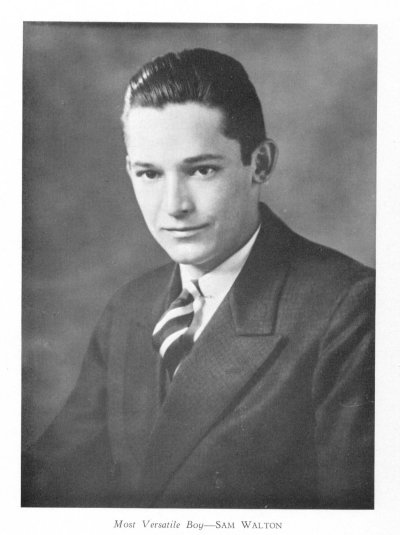
Sam Walton Walmart’s success story is a fascinating journey of determination, innovation, and risk-taking that transformed the retail landscape in the United States. In this blog post, we will delve into the life of Sam Walton and his relentless pursuit to create one of the most successful retail chains in history.
We will begin by exploring Sam Walton’s humble beginnings and early experiences with retail work at J.C. Penney. Subsequently, we’ll examine his time in the armed forces during WWII and how he encountered Helen Robson. As we continue our exploration into Sam Walton Walmart’s evolution, you’ll learn about how he turned around a struggling Ben Franklin variety store by breaking conventional retail norms.
The challenges faced by Sam didn’t end there; losing it all due to a lease mishap led him to start over with Walton’s Five & Dime. We’ll examine how embracing self-service concepts revolutionized his business model before delving into the birth of Walmart itself and its rapid expansion across small towns in America.
Lastly, discover how going public fueled further growth for Walmart while launching innovative ventures like Sam’s Club solidified its position as an industry leader – ultimately leading to today’s success underpinning the legacy left behind by Mr. Sam Walton himself.
The Humble Beginnings of Walmart’s Founder

Sam Walton, a poor farmer’s son, worked odd jobs while traveling with his family in search of better opportunities.
He joined J.C. Penney as a management trainee, but was considered one of the company’s worst employees.
Early Life and Struggles
Sam was raised during the Great Depression and possessed a firm understanding of thriftiness and hard labor. He took on multiple jobs such as milking cows and delivering newspapers to support his family, to help make ends meet for his family.
Introduction to Retail at J.C. Penney
In 1940, Sam began working at J.C. Penney where he learned various department store retail sales skills that would later contribute to his success with Walmart.
Despite being labeled as one of their worst employees due to tardiness issues, this experience laid the foundation for his future retail empire.
Military Service and Marriage

Joining the war effort
Sam Walton enlisted in the military during World War II and was eventually stationed in Oklahoma. As an Army Intelligence Officer, Sam Walton contributed to the nation’s defense efforts during the war, shaping his leadership style later on.
Meeting Helen Robson
Sam met Helen while being stationed in Oklahoma, then the couple became married on Valentine’s Day in 1943 after a brief courtship period. Helen played a crucial role in Sam’s life and success, supporting and encouraging him through challenges faced while building Walmart into one of the world’s largest retailers.
Turning Around The Ben Franklin Store
In 1945, Sam Walton bought a struggling Ben Franklin store located in Newport, Arkansas for an inflated price, but he didn’t let that stop him from turning it into a retail powerhouse.
Acquiring the failing store
Sam saw potential in the failing store and decided to take on the challenge of turning it around with his hard work and determination.
Breaking conventional retail norms
Sam devised three strategies to reverse the misfortunes of the failing Ben Franklin store:
- Bargain pricing: Sam introduced lower prices than his competitors, which helped attract customers and increase sales volume.
- Creative merchandising: He used innovative display techniques to showcase products effectively and make them more appealing to customers.
- Focused customer service: Sam emphasized excellent customer service as a key differentiator from other retailers, which helped build customer loyalty.
Sam Walton’s success with the Ben Franklin store is a testament to his entrepreneurial spirit, willingness to take risks, and innovative retail strategies.
Losing It All And Starting Over
Although things were progressing along nicely, hardships were not inevitable. In 1945, Sam Walton lost everything due to a lease renewal oversight, which nearly devastated him.
Learning From Mistakes
This detrimental setback was excuse enough for Sam to give up and move on to a safer, steadier career outside of retail. Instead, Sam Walton’s lease mishap taught him to be more cautious about property leases, shaping Walmart’s future real estate strategy.
From Five & Dime to Walmart
In 1950, Sam moved his family to Bentonville, Arkansas which satisfied both his wife’s desire to for small-town living and his hobby for quail hunting during rotating seasons across multiple states.
In his new location, Sam purchased another store, this time Luther Harrison’s Variety Store, smack dab in the middle of Bentonville’s central square– a prime location. This milestone marked the first time that he used his surname and opened “Walton’s Five & Dime” that same year.
Immediately following the purchase, he held a remodeling sale which not only moved inventory and drastically boosted sales, it made a statement about the new ownership and style of business to townsfolk.
Walton’s Five & Dime was the foundation for Walmart, now the largest retailer in terms of sales figures.
Embracing the Self-Service Concept
Sam Walton and his team made a revolutionary move in the retail industry by introducing self-service, allowing customers to shop without assistance while reducing staffing costs, thus tripled sales within a year. This concept quickly revealed these advantages:
- Lower prices: Walmart’s early adoption of self-service allowed them to offer lower prices and stay ahead of competitors.
- Tripled sales: Implementing self-service proved successful, with sales tripling in less than a year.
- Convenience and cost savings: Customers appreciated the convenience and cost savings provided by self-service.
- Benefits of self-service: Self-service not only reduces staffing costs but also allows for faster checkout and greater customer control over the shopping experience.
- Self-service in other industries: The self-service concept has since been adopted in other industries, such as banking and hospitality, to improve efficiency and customer satisfaction.
Source: The Balance Small Business
Birth of Walmart and Its Rapid Expansion

In 1962, Sam Walton opened the first Walmart store by mortgaging his house and borrowing money. The company’s unique approach of offering discounted products in large stores located in small towns led to rapid growth with over 1,000 stores and 150,000 employees by 1990. The two main factors of this success were:
- Opening the first Walmart store: Sam took a bold step into retail history when he launched his innovative discount chain.
- Undercutting competitors through high volume sales: By focusing on low prices and efficient operations, Walmart quickly gained market share from traditional retailers.
Going Public and Innovations
In 1970, Walmart went public to raise capital and expand operations, paying off debts and replacing wooden shelves with metal ones for cost reduction purposes. The two main reasons for this are:
- Capitalizing on going public: Walmart’s decision to go public allowed them to grow exponentially.
- Introducing Sam’s Wholesale Clubs: Walmart diversified its customer base by launching Sam’s Wholesale Clubs in 1983, catering to small businesses and bulk buyers.
The Legacy of Sam Walton and Today’s Success

Despite facing opposition, Sam Walton left behind a retail empire that generates over half a trillion dollars in revenue annually, making Walmart the largest employer and retailer worldwide.
Walmart’s prosperity is credited to its adherence to economical costs, pioneering retail techniques, and ceaseless growth.
Under CEO Doug McMillon’s leadership, Walmart continues to grow with initiatives such as investing billions into employee wages and training programs.
Statista reports Walmart’s net sales worldwide since 2006.
FAQs in Relation to Sam Walton Walmart
What was Sam Walton’s idea for Walmart?
Sam Walton’s idea for Walmart was to offer low prices by leveraging high volume sales, efficient distribution systems, and strong supplier relationships, while providing exceptional customer service in rural areas with less competition.
What are 5 interesting facts about Sam Walton?
- Sam started his retail career at J.C. Penney.
- He served in the U.S. Army during World War II.
- In 1985, Forbes named him the richest man in America with an estimated net worth of $2.8 billion.
- Walton received the Presidential Medal of Freedom from President George H.W. Bush in 1992.
- The University of Arkansas established the Sam M. Walton College of Business in his honor after he donated $50 million to support it.
What are details about Sam Walton?
Samuel Moore “Sam” Walton was born on March 29, 1918, and founded Walmart and Sam’s Club chains. He built one of the largest global retailers through innovation and cost-cutting strategies while focusing on customer satisfaction, starting from humble beginnings working at J.C. Penney.
What made Sam Walton so successful?
Sam Walton’s success can be attributed to embracing self-service concepts, targeting underserved rural markets, negotiating lower costs from suppliers, implementing advanced logistics systems, offering everyday low prices (EDLP), constantly innovating within company operations, and fostering a strong corporate culture with an emphasis on customer service.
Conclusion
Sam Walton took a failing store and turned it into the retail giant known as Walmart, thanks to his hard work and innovative thinking.
He shook up the industry with his unconventional strategies, like self-service concepts and high volume sales, and his legacy lives on today.
Retail professionals can learn from his determination and willingness to break norms in order to succeed.
